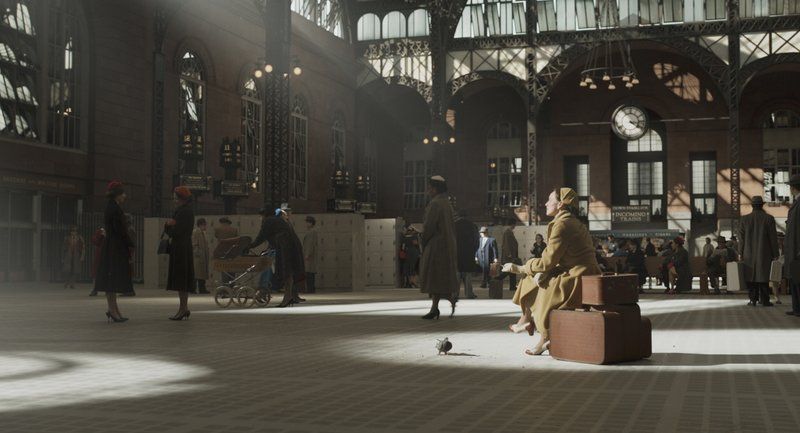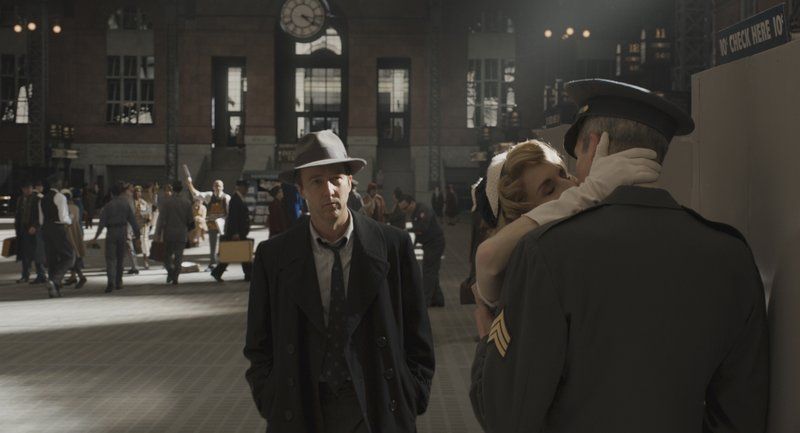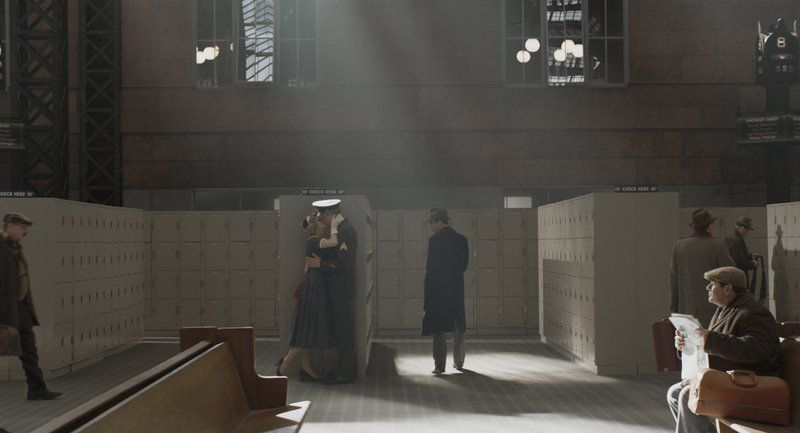Artist-Led Tour of "ENCORE" Photo Exhibit w/ Mark S. Kornbluth
Join photographer Mark S. Kornbluth for a visual exploration of NYC's Broadway theaters at Cavalier Galleries!


Motherless Brooklyn is one of the very “New York” movies coming out this fall, a film-noir mystery set in 1950s based on the beloved book Motherless Brooklyn by Jonathan Lethem. The movie is written, directed and produced by Edward Norton, who also stars as the tourettes-inflicted private eye whose investigation of the murder of his boss takes him into New York City’s underworld, revealing the development forces upending the lives of large swaths of the population. Fans of New York City history will recognize a thinly-disguised Robert Moses character, called Moses Randolph, played by Alec Baldwin, a Jane Jacobs-inspired character played by Cherry Jones, and an all-star cast rounded out by Willem Dafoe, Gugu Mbatha-Raw, Bobby Carnavale, and Bruce Willis.
New York City itself is a true star in Motherless Brooklyn, which we had the opportunity to view at a recent screening in New York City. Norton, his set designers and location managers painstakingly recreated a bygone New York in a story that takes its characters from the jazz clubs of Harlem, to a crumbling Brooklyn, and finally to the almost impenetrable world of the city’s power brokers. One of the most impressive feats in the film is the recreation of the original Penn Station, a combination of VFX and a physical set. We spoke with Beth Mickle, the production designer for Motherless Brooklyn who shared behind-the-scenes details on how the lost train station, demolished in 1963, was brought back to life for a critical scene in the film.
Mickle tells us that the appearance of old Penn Station in the movie can be credited to the steadfast vision of Norton, saying “it was all entirely Edward being really insistent that we show Penn Station and show the original one.” Many on the production team suggested using Grand Central Terminal in Penn’s stead, the grand transportation hub in New York City that was fortunately saved from demolition. Still standing and operational, it would have been more cost effective for the film, but Norton understood how the station’s fate ties into one of the main themes of Motherless Brooklyn, “to really show what happened with the modernization of a city and some of the decisions that are made. Just by putting that scene there, keeping it there for this very pivotal moment, [it] will really drive home the point to audiences that this decision was made to tear down that building.”

Penn Station as recreated in Warner Bros. Pictures’ drama “MOTHERLESS BROOKLYN,” a Warner Bros. Pictures release. Courtesy of Warner Bros. Pictures © 2019 Warner Bros. Ent. All Rights Reserved
For the recreation of Penn Station, Mickle and her team began by gathering historical imagery from the Library of Congress, the NYPL Digital Collections, and the film the Seven Year Itch that featured a scene shot in the original station. In this process, they were particularly interested in what would show “architectural details, as well as placement of the lockers, benches, staircases, signage, kiosk dressing,” and other elements. They also came across original blueprints of Penn Station, which were used by the VFX team to recreate the layout of the station.
Then, in discussions between Norton, VFX Supervisor Mark Russell, Director of Photography Dick Pope, and the producers, it was decided what was physically needed on set for the action that was going to take place. “We determined that we needed to build a physical entrance door and hallway leading to a set of stairs,” Beth explains, “Then we needed long stretch of flooring that matched the original Penn Station flooring—this would be the path that Edward walks along, so that VFX didn’t have to recreate the whole stretch of flooring that Edward’s feet touched.” The original floor was made of concrete and inlaid glass block, and the production team created a 15-foot wide by 100-foot long walkway by replicating the pattern found in historic photos and printing it onto linoleum flooring rolls. It was so detailed, Beth says, that the graphic designer Donna Kim even added the drop shadows for each of the glass blocks and added little glimmers of light to emphasize the reflectiveness of the glass. The same digital pattern was then used by the visual coordinator and multiplied out through the rest of the scene in VFX.

(L-R) EDWARD NORTON as Lionel Essrog, BETH MICKLE and RUSSELL BARNES as Penn Station Lovers and in Warner Bros. Pictures’ drama “MOTHERLESS BROOKLYN,” a Warner Bros. Pictures release. Courtesy of Warner Bros. Pictures © 2019 Warner Bros. Ent. All Rights Reserved
The lockers were particularly important — a major plot point takes place here — so they used real lockers and benches, along with three vendor kiosks with merchandise. “As Edward and the extras were interacting with these pieces, it was better to have them physically rather than have VFX recreate them,” Beth says. The lockers, of which hundreds were needed, were some of the most difficult elements to source and recreate accurately on a tight budget. Beth tells us, “I know it sounds like a silly thing, but we just had hundreds of hundreds of lockers to get, and they had to be period correct, and all painted the right color. And we had a lot of trouble trying to find lockers that were right for the period in the quantity that we needed.” They finally arrived at the eleventh hour, much to everyone’s relief. When looking for art design inspiration, they ended up finding vintage metal engraved locker numbers from another train station on sale on Etsy, and they used those on the lockers that appeared directly in the scene. The other locker numbers, on sides of the locker banks that aren’t visible in the film, were printed on vinyl. Finally, the benches were sourced by set decorator Kara Zeigon from a church “getting rid of their pews for nearly no cost!,” says Mickle.

(L-R) EDWARD NORTON as Lionel Essrog, BETH MICKLE and RUSSELL BARNES as Penn Station Lovers and in Warner Bros. Pictures’ drama “MOTHERLESS BROOKLYN,” a Warner Bros. Pictures release. Courtesy of Warner Bros. Pictures © 2019 Warner Bros. Ent. All Rights Reserved
In the filming of the scene, which was shot in an approximately 20,000 square foot soundstage, the VFX coordinator dropped in rough digital surroundings to show the actors how VFX would eventually fill in the rest of the set — a glimpse of Penn Station being brought back to life. Also mapped out were the large beams of light that came in through the windows, precisely placed by marking where the windows would have been located and their dimensions, “so it was all going to match up exactly with the real architecture from Penn Station.”
And look closely when you see this scene in the film — Mickle is an extra! “Edward asked me to play the woman who’s kissing a soldier in uniform next to the hero row of lockers he goes to. So my husband Russell Barnes and I can be seen smooching as he rounds the corner of the main row of lockers!”
All of this attention to detail pays off handsomely in Motherless Brooklyn. The recreation of the lost Penn Station makes a big impact, whether the viewer is aware initially or not that it’s a lost train station. What is clear is that there are so few majestic spaces left like old Penn Station left in New York City, and hopefully that curiosity will spark interest after for audiences. The effort here is just a reflection of the rest of the wonderful set details in Motherless Brooklyn that transport viewers back seventy years. In the film, you’ll find filming locations throughout New York City like Robert Moses’ Triborough Bridge Authority building on Randalls Island, the New York Academy of Medicine, the New York County Supreme Court, the pool of the YMCA at West 63rd Street, the former public bathhouses of New York City, the New York Public Library reading room at 42nd Street, the Plaza Hotel, Washington Square Park, and the historic townhouses of Bedford-Stuyvesant, Brooklyn and upper Manhattan, and more.
Motherless Brooklyn will be released on November 4, 2019. There’s a chance for the public to see it early on October 11th at the New York Film Festival.
Join us on our next tour of the Remnants of Penn Station where you’ll be able to see the original glass blocks in person, along with numerous other pieces left of the old station:
Subscribe to our newsletter